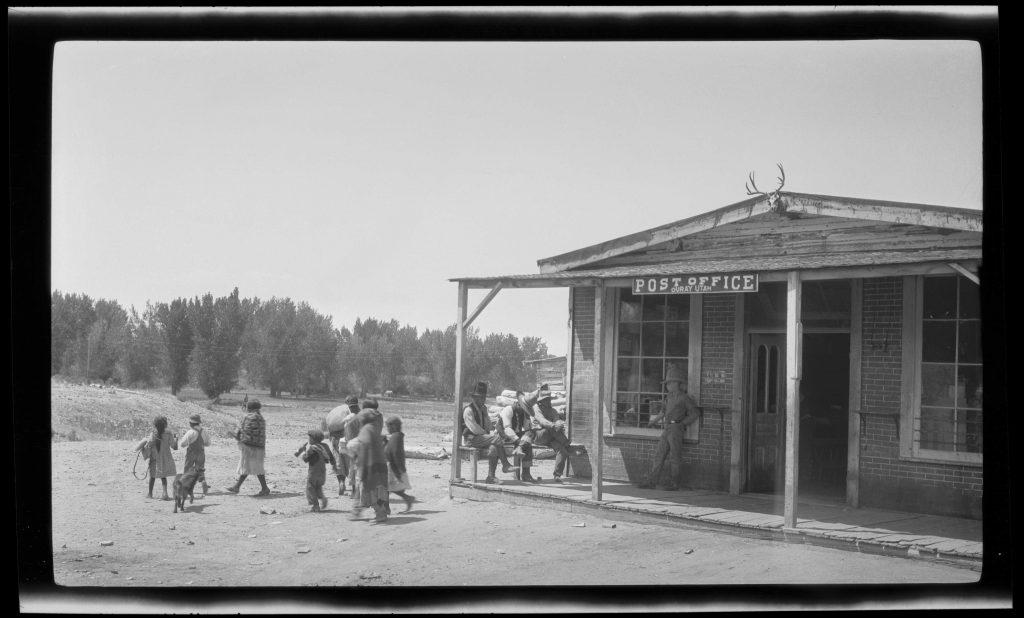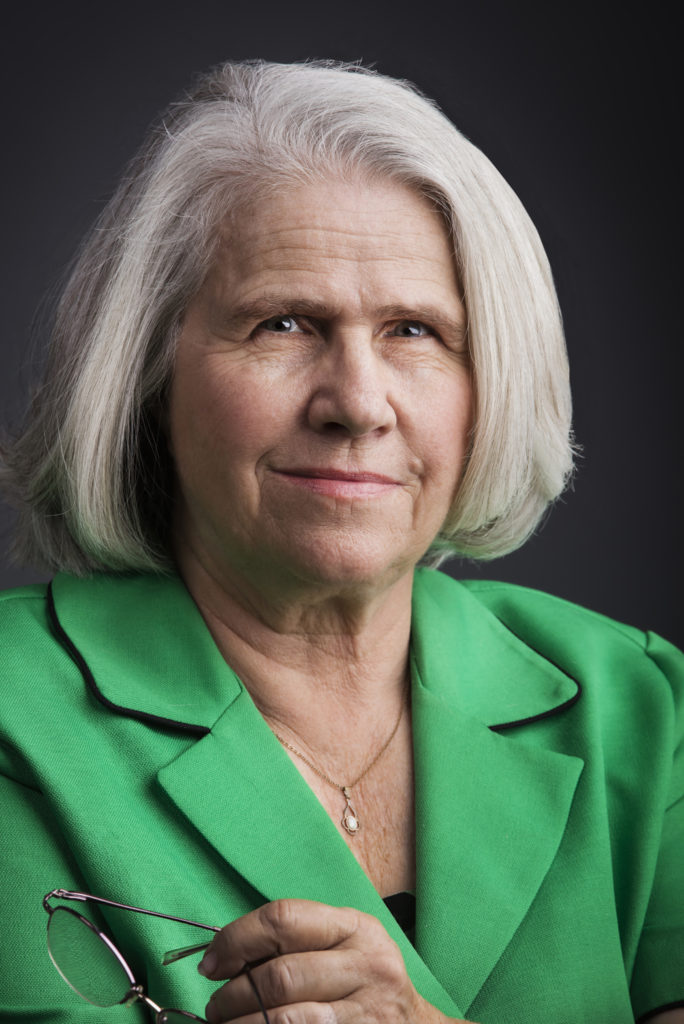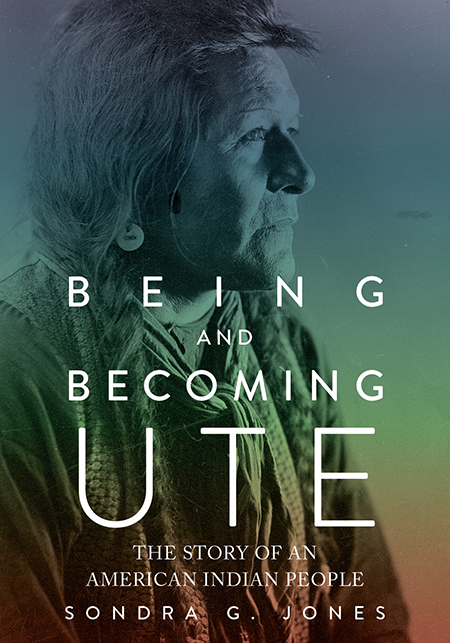Date: 01.10.2020 (Season 1, Episode 10; 36:18 and 25:40 minutes [two audio segments]). Click for the part one and part two BuzzSprout versions of this Speak Your Piece Episode.
The above image is entitled “Ute Indians in costume.” Tribal leaders, circa 1910, posing in regalia during an annual fair. Courtesy of the Utah State Historical Society. Second from left on a white horse is Rose Daniels, born in Navajo in the 1840s, kidnapped and traded into slavery. Daniels settled among the Utes in the Uintah Basin. The Utes were forced into the northeastern lands of Utah Territory, beginning in the mid 1860s from central Utah and western Colorado. The Uintah-Ouray Reservation is a confederation of many Ute peoples including the Timpanog (Timpanogos), Uintah, Tabeguache, Grand, Yampa and more. Are you interested in other episodes of Speak Your Piece? Click here for more episodes.
Podcast Content:
In this free ranging conversation Dr. Sondra Jones speaks about her book Being and Becoming Ute: The Story of an American Indian People (University of Utah Press, 2019) which weaves centuries of history (oral traditions, ethnographic, geographic, military, cultural and more) of the Ute people, whose homelands encompass Utah, Colorado, Nevada, Arizona and beyond.
Jones’ book features Ute triumphs, losses, successful adaptive strategies and life-ways, intertribal connections, centuries of reciprocity and conflict with other Native Americans, Hispanics and white traders, travelers, and trappers, Mormon settlers, miners, ranchers and more. Jones brings to life tribal and band leaders, the constantly changing near-genocidal effect of US Indian policies, federal and church-based Indian schools, Ute trading and emerging economic practices. Jones then tells the present story of a thriving contemporary urban and reservation-based Ute society.
Podcast Episode (Part 1):
Podcast Episode (Part 2):
Jones has researched, studied, and written about the Ute people for almost fifty years. Jones describes herself and her ancestors as white and as “Mormon as they get.” However, Jones’ longtime husband–a Ute Sundance dancer who was born and raised in Los Angeles, California. Is an urban Indian; school teacher to the Navajo; part Colorado Hispanic and part Tohono O’odham–along with their ten children, joined Sondra in a life that has included exchanges with thousands of Ute people and leaders, listened to hundreds of interviews, and years of research in federal, state, private and tribal collections from California to Washington D.C. This book represents a deeply immersive and emphatic study by Jones of a worldview and history of the Ute people.
What this interview and the reading of Jones’ book brought home to me (again), is that Western history, and especially Utah history, can no longer be presented, especially to school age children, without a requisite telling of the Native American story.

Caption: Ute children, women and men (the latter seated on the porch); Ouray, Utah, Post Office, circa 1910; Ottinger Collection, Utah State HIstorical Society
Topics Discussed in Time:
Part One
- Minute: 00:00 – 12:27 Introduction: Host Brad Westwood introduces ethnohistorian Sandra G. Jones, her book Being and Becoming Ute is the focus of this episode. Dr. Jones emphasizes how the Utes adapted over the course of four centuries. Jones explains her connection to the topic of Native American history and the heritage her children inherited. Her husband is Native American and a Ute Sun Dancer (the most important spiritual ceremony of the Ute tradition)
- Minute: 12:27– 25:15 Sandra G. Jones describes her methodology and process while writing her book. She includes the historical, political and economic history of the Ute people in Utah but also the cultural context and perspective necessary for a comprehensive history. Jones explains Ute trade in this segment and how horses changed the Ute’s way of life.
- Minute: 25:15 – 33:08 What is tradition? Traditions don’t stay the same; cultures are ever changing. Environment, ecology and geography determine culture. Ute traditions are ever changing because of forced migration and time.
- Minute: 33:08 – 36:18 Sandra G. Jones describes her project in Upstate New York in which she focuses on the Iroquois during the second religious revival.
Part Two
- Minute: 00:00 – 11:30 Being and Becoming Ute offers the not well known 20th century story of the Utes. Dr. Jones tells how the Utes learned to use the law in court and protect their livelihood. Ute tribe members began to travel outside of the reservations and participate in universities and create their own businesses.
- Minute: 11:30 – 17:13 Ute leader Ouray is known as a chief of the Tabeguache Ute tribe. His leadership abilities led him to negotiate for the prosperity of the Ute people.
- Minute: 17:13 – 24:00 Another famous Ute leader, Chief Wakara, is discussed in this segment along with a brief history of the Utes relationship with early Latter-Day Saint pioneers.

Bio: Dr. Sondra G. Jones has a PhD in U.S. History from the University of Utah (2013) and has taught American and Utah history and Native American Studies at the University of Utah, Brigham Young University and Utah Valley University. Author of over a dozen articles on Native American history, Jones also published a work on Native American slavery in the 19th century entitled The trial of Don Pedro León Luján (University of Utah Press, 2000). She and her husband Robert Jones live in Utah County.

Additional Resources & Readings:
To read about and purchase a copy of Being and Becoming Ute: The Story of an American Indian People (2019), go to the University of Utah Press (hard copy, soft and eBook) or gather up the ISBN number (9781607816577) and high tail-it to your local independent bookseller and order a copy there.

If Dr. Jones’ interview and book interests you, you may also want to read A History of Utah’s American Indians, written by Forrest Cuch (Ute), former director of the Utah Division of Indian Affairs. This work captures the politics, family life, social interactions, migration and wars of Utahs six official tribes. Go to Utah State University Press (hard copy and digital) to purchase a copy.
On Thursday October 7th 2021, Forrest spoke at the Cyrus Dallin Art Museum (Arlington, MA). His remarks where entitled “On History & Healing: Honoring Indigenous Peoples Day.” You may also want to watch and listen to this event — https://youtu.be/NPkCT6SInEI
Do you have a question or comment, or a proposed guest for “Speak Your Piece?” Write us at “ask a historian” – askahistorian@utah.gov

